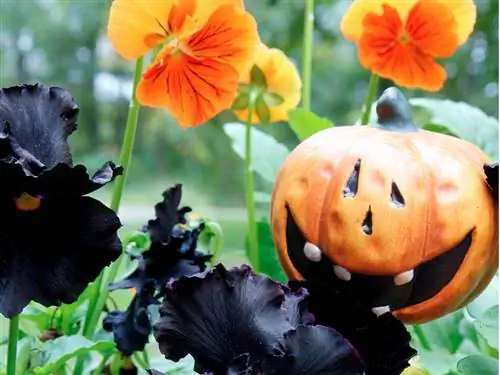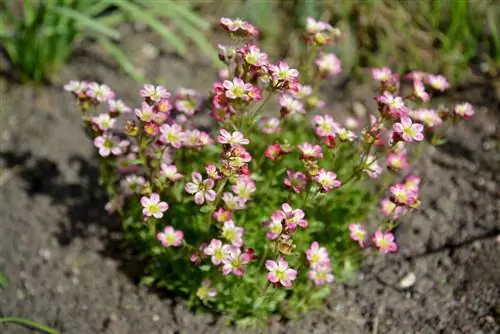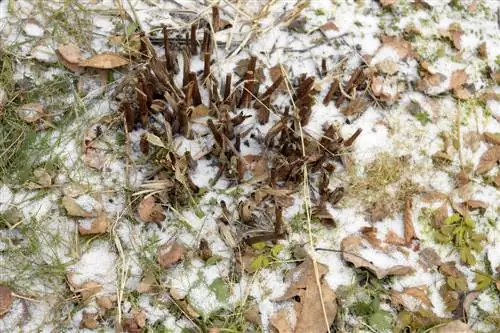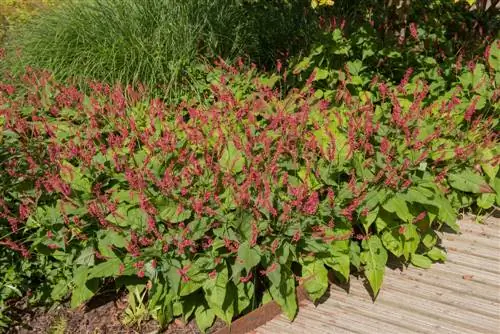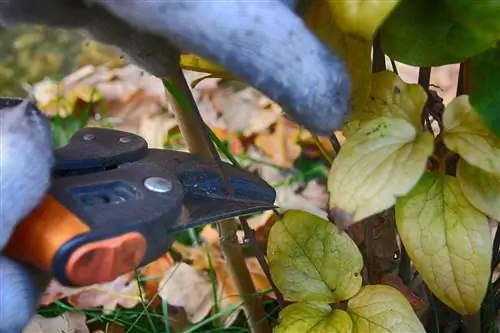- Author admin [email protected].
- Public 2023-12-16 16:46.
- Last modified 2025-01-23 11:21.
Home gardeners give their perennials a well-deserved winter break in the fall with a vigorous pruning. This guide explains the correct cut. Find out here which perennials should be spared from autumn pruning.
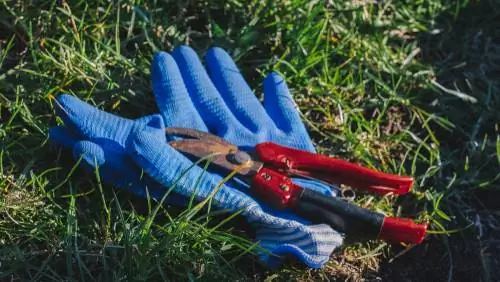
How do you cut perennials correctly in autumn?
Cutting perennials in autumn: Use a perennial sickle, knife or secateurs, gloves to protect against toxic plant sap. Gather withered shoots in bunches and cut them approx. 10 cm above the ground to avoid damaging overwintering buds.
Cut off faded perennials in clumps
In autumn, most perennials are only a shadow of their former self. During the season, the magnificent beauties have completely exhausted themselves and also diligently looked after offspring. Shortly before the onset of winter, all parts of the plants above ground died. Now is the ideal time window for pruning care. This is how you properly prune drawn-in perennials:
- Recommended cutting tools: perennial sickle (€18.00 on Amazon), knife or secateurs
- Put on gloves to protect against poisonous plant sap, like with peonies
- Clutch the withered shoots with one hand
- With the cutting tool in your other hand, cut about 10 cm above the ground
The safety distance from the ground prevents valuable overwintering buds from being accidentally cut off. Ideally, you should spread a thick layer of leaves and needle twigs over the cut perennials so that the root ball in the ground is well protected from constant winter wetness.
Do not cut perennials with a winter aspect
A wide range of decorative perennials adorn the winter garden with evergreen, brightly colored leaves or attractive seed heads. When dreary melancholy takes hold in the bed, the indestructible perennials provide eye-catching accents. At the latest when winter puts a snow cap on the seeds and fruit heads, you will be grateful that you didn't use the scissors at this point. The following perennials are spared from autumn pruning:
- Architecture flowers (Iberis)
- Golden strawberries (Waldsteinia)
- Purple bells (Heuchera)
- Bergenia (Bergenia)
- Sedum (Sedum)
- Red-leaved spurge (Euphorbia amygdaloides)
- Yarrow (Achillea)
Winter-flowering perennials, such as the unique snow rose, also known as Christmas rose (Helleborus), are also excluded from autumn pruning.
Cutting grass in spring
Ornamental grasses enchant the otherwise empty garden with their stalks and picturesque ears. For pruning, do not reserve deciduous species until early spring. In late winter, they only comb out winter and evergreen grasses with their hands.
Before Grim Reaper arrives in the garden, tie the clusters loosely together with string. This means that the sensitive heart of the plant is well protected from moisture and severe frost. Animal winter guests appreciate grasses as a safe place to retreat. Even hollow stems are often used by local insects as a much sought-after winter quarters. Thanks to the seeds, hungry birds get through the lean season safely.
Tip
Unlike perennials, autumn pruning is taboo for most shrubs and trees. Cutting encourages twigs and branches to sprout in a herbaceous, soft manner. The time window until the first frost is too short for the young shoots to mature and become woody. The fatal consequences are frostbite, which can extend deep into the wood. With a few exceptions, the main date for pruning is in late winter.


